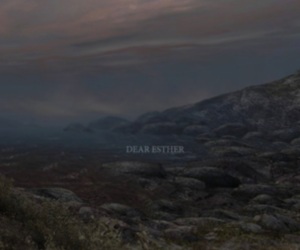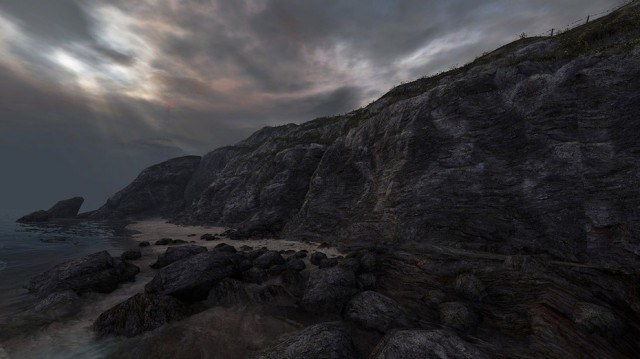Dear Esther Review
 Game: Dear Esther
Game: Dear Esther
Developer: The Chinese Room
Publisher: The Chinese Room
Available on: PC & Mac (Reviewed on PC)
Many reviews of Dear Esther, the narrative experiment borne of a Half Life 2 mod, have sought to define what it is, and they have drawn a variety of conclusions. Some feel that its lack of objectives and interactivity prevent it from being a true “game”. Others conclude that it’s a game because it isn’t anything else, and many believe that it somehow elevates gaming by railing against the confines of the medium
While all these viewpoints are valid, doubly so when you consider that Dear Esther was partly crafted to spark debate (for more on the game’s unique background, read our interview with Dan Pichbeck or head for the official site), they can fail to address a fairly basic question that a reader may reasonably expect to see answered ina review: is Dear Esther any good? Can a three-hour walk through a static gameworld deliver an experience that’s worth having, or is it merely an exercise in intellectual masturbation?
Despite starting life as an exploration of the narrative potential of games, Dear Esther doesn’t really have a story. No, it’s more a scenario: a woman is killed by a drunk-driver, and her bereaved husband retreats to a Hebridean Island to find closure. You, an unspecified person or entity, wander the island as the narrator reads disjoined and achronological letters to his late wife.

The game begins on a grimy concrete jetty, beneath a lighthouse. Ahead of you stands a shed, with the door open. The controls – WASD and mouse to look – seem normal, so it takes you a few minutes to realise that the shed contains neither key, pistol or crowbar, and that your well-honed gamer’s instincts to search, loot and destroy are useless here. Even if you approach Dear Esther with a full understanding of its mission and context, the opening is still terribly disorientating, and it’s not exaggerating to liken it to falling through the looking glass into perhaps the most immersive game ever made.
Because there are neither interactive elements nor threats, you start taking in your surroundings in a way that you would if you were actually on the island. Traditional level design is such that we tend to look upon gameworlds with blinkers, filtering out everything that signifies neither objective nor threat. Yes, design, appearence and detail and can be put to great narrative effect, but when you must accomplish certain tasks in order to progress, exploring the environment becomes a means to an end. It’s only once you’ve been unleashed on Dear Esther’s island that you realise how much game conventions prevent you from being in their worlds. Even the painstakingly crafted environments of BioShock and Deus Ex: Human Revolution are compromised by the fact that players are trained to separate interactive from non-interactive elements.
For its part, Dear Esther honestly feels more like going for a walk than it does playing a game, and since walking outside alone can lead anyone to introspection and clarity, it makes sense that Pinchbeck chose such a setting for his haunting tale of disorientating bereavement. As we wander the island, we see the ways in which the narrator has desperately tried to make sense of his wife’s death. Scrawled chemical symbols (for alcohol) and electrical diagrams (for car breaking systems) show how he has tried to use science and logic to rationalise the trauma of Esther’s accident.

Though arguably too simple a metaphor for the way he processes his grief, the diagrams, etched into walls or daubed on cliff faces with luminous paint, are arresting and disturbing, since for all their size and complexity, they’re as meaningless (in this context) as the event itself. These remnants of a troubled mind are something that video games are uniquely placed to show us, since they are perhaps the only medium that can give us such a deep relationship with our environment, and the people that shape it. It’s Dear Esther’s great achievement that this is never diluted.
The flip side of that, of course, is a sense of detachment. Nothing you do (and aside from shining a torch in dark areas, you don’t really do anything) has any impact upon the gameworld, and the voiceover is arguably a bit of a narrative cop-out. I say arguably, the content of the letters is vital to the game’s impact, and making us read them could be an exercise in tedium. It’s just that there’s a conspicuous separation between the haunting reality of the slow walk around the island, and the dramatic artificiality of the voiceover.
The only other criticism it’s possible to make is of the route you have to take around the island. Though the path is open enough to give you the sense that you’re exploring, you never quite have the freedom that would complete the almost total sense of immersion. The sections on the island’s clifftops and rock pools reveal that you are unable to climb surfaces that are slightly rocky or steeply angled, while wandering too far off the path will result in you being “retrieved” by the narrator against a too-symbolic backdrop of motorway lights.
These dent Dear Esther’s precious illusion. Though it feels churlish to point out flaws in the execution of something so original and so beautiful, its near success makes its awkward moments harder to overlook. Still, these are only small issues, and since you should really give Dear Esther your fullest attention and deepest faith, they won’t harm the experience of someone who wants to get lost in it.

If Dear Esther was just a “game”, then the separation between your experience, your actions and any events at all consititute a severe limitation. As it is, this actually manages to tap into some of our deepest fears, that everything we do is pointless and that everything that happens is meaningless. Much as we like to think that our lives have a story and a direction, we’re fumbling for meaning as much as Dear Esther’s narrator, and skating over the surface of events as much as its impotent protagonist. We try to organise our thoughts into coherent narratives, and we try to impact upon a world that threatens to forget us as soon as we’ve turned our backs.
The ethereal, sliding journey across (and at one point, spectacularly, through) Dear Esther’s inscruitable island stirs up the deeply unsettling feeling that life is no more than a set of fragmented voices, unclear paths and meaningless symbols. The fact that that journey feels so real only serves to make it more troubling.
VERDICT: It’s a shame that gamers are the only ones who are likely to play Dear Esther. Not because it might convince non-gamers that games are for grown-ups (that one’s getting old now), but that it’s a profoundly affecting experience that is unlike anything else, in any medium. It’s not quite perfect, but you owe it to yourself to overlook its tiny faults and submerge yourself completely in its uncomfortable reality. To make bold proclamations about the future of interactive narrative that Dear Esther (no doubt) heralds is to do it a disservice. This is a piece of art that deserves to be appreciated on its own terms.





